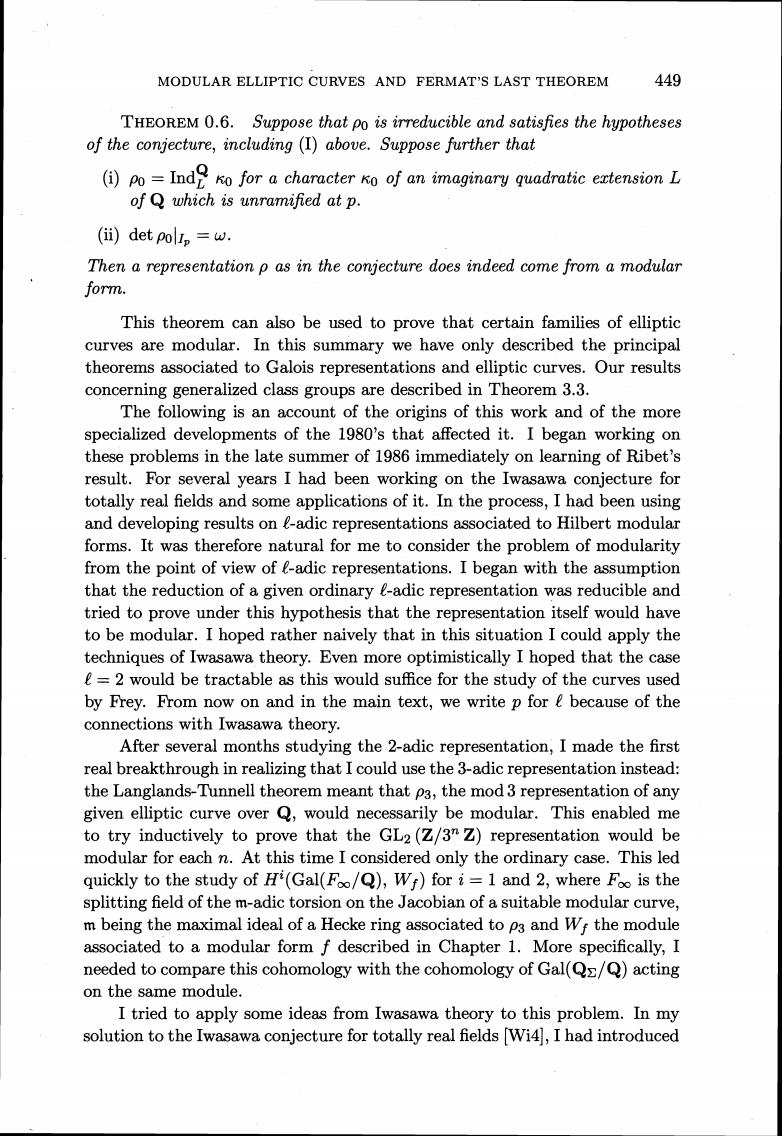正在加载图片...

MODULAR ELLIPTIC CURVES AND FERMAT'S LAST THEOREM 449 THEOREM 0.6.Suppose that po is irreducible and satisfies the hypotheses of the conjecture,including(I)above.Suppose further that (i)po=Ind ko for a character ko of an imaginary quadratic extension L of Q which is unramified at p. (ii)det=w Then a representation p as in the conjecture does indeed come from a modular form. This theorem can also be used to prove that certain families of elliptic curves are modular.In this summary we have only described the principal theorems associated to Galois representations and elliptic curves.Our results conc erning generalized class groups are described in Theorem 3.3 The following is an account of the origins of this work and of the more result.For several years I had been working on the Iwasawa conjecture for totally real fields and some applications of it.In the process,I had been using and developing results on (-ad representations associ iated to Hilbert modular forms.It was therefore natural for me to consider the problem of modularity from the point of view of (-adic representations.I began with the assumption that the reduction of a given ordinary -adic representation was reducible and tried to prove under this hypothesis that the representation itself would have to be modular.I hoped rather naively that in this situation I could apply the techniques of Iwasawa theory.Even more optimistically I hoped that the case =2 would be tractable as this would suffice for the study of the curves used by Frey.From now on and in the main text,we write p for e because of the connections with Iwasawa theory. After several months studying the -adic representation,I made the firs real breakthrough in realizing that I could use the 3-adic representation instead: the Langlands-Tunnell theorem meant that pa,the mod 3 representation of any given ellin Ptic curve over Q,would necessarily be modular. This enabled m to try inductively to prove that the GL2(Z/3"Z)representation would be modular for each n.At this time I considered only the ordinary case.This led quickly to the study of H(Gal(F/Q),W)for i=1 and 2,where F is the splitting field of the m-adic torsion on the Jacobian of a suitable modular curve. m being the maximal ideal of a Hecke ring associated to ps and Wr the module associated to a modular form f described in Chapter 1.More specifically.I needed to compare this cohomology with the cohomology of Gal(Q/Q)acting on the same module. I tried to apply some ideas from Iwasawa theory to this problem.In my fields [Wi,Ihad introducedMODULAR ELLIPTIC CURVES AND FERMAT'S LAST THEOREM 449 THEOREM 0.6. Suppose that po is irreducible and satisfies the hypotheses of the conjecture, including (I) above. Suppose further that (i) po = 1ndF KO for a character KO of an imaginary quadratic extension L of Q which is unramified at p. (ii) detpOllp= W. Then a representation p as in the conjecture does indeed come from a modular form. This theorem can also be used to prove that certain families of elliptic curves are modular. In this summary we have only described the principal theorems associated to Galois representations and elliptic curves. Our results concerning generalized class groups are described in Theorem 3.3. The following is an account of the origins of this work and of the more specialized developments of the 1980's that affected it. I began working on these problems in the late summer of 1986 immediately on learning of Ribet's result. For several years I had been working on the Iwasawa conjecture for totally real fields and some applications of it. In the process, I had been using and developing results on t-adic representations associated to Hilbert modular forms. It was therefore natural for me to consider the problem of modularity from the point of view of t-adic representations. I began with the assumption that the reduction of a given ordinary C-adic representation was reducible and tried to prove under this hypothesis that the representation itself would have to be modular. I hoped rather naively that in this situation I could apply the techniques of Iwasawa theory. Even more optimistically I hoped that the case t = 2 would be tractable as this would suffice for the study of the curves used by Frey. From now on and in the main text, we write p for t because of the connections with Iwasawa theory. After several months studying the 2-adic representation, I made the first real breakthrough in realizing that I could use the 3-adic representation instead: the Langlands-Tunnel1 theorem meant that p3, the mod 3 representation of any given elliptic curve over Q, would necessarily be modular. This enabled me to try inductively to prove that the GL2 (Z/3n Z) representation would be modular for each n. At this time I considered only the ordinary case. This led quickly to the study of ~~(Gal(p,/~), Wf) for i = 1and 2, where F, is the splitting field of the m-adic torsion on the Jacobian of a suitable modular curve, m being the maximal ideal of a Hecke ring associated to p3 and Wf the module associated to a modular form f described in Chapter 1. More specifically, I needed to compare this cohomology with the cohomology of Gal(Qc/Q) acting on the same module. I tried to apply some ideas from Iwasawa theory to this problem. In my solution to the Iwasawa conjecture for totally real fields [Wi4], I had introduced